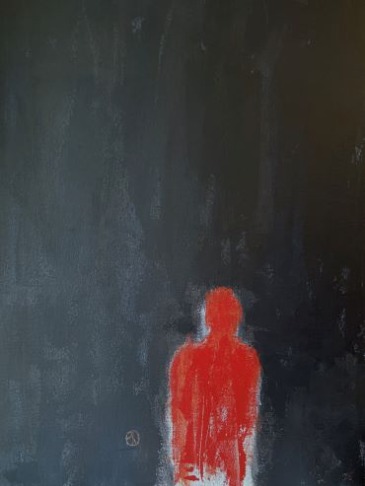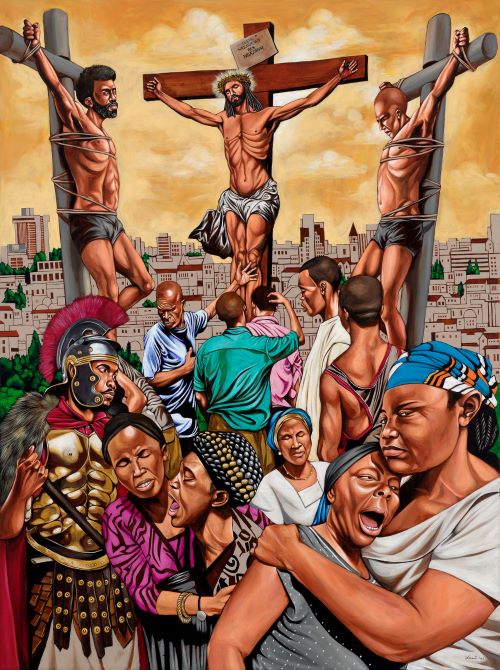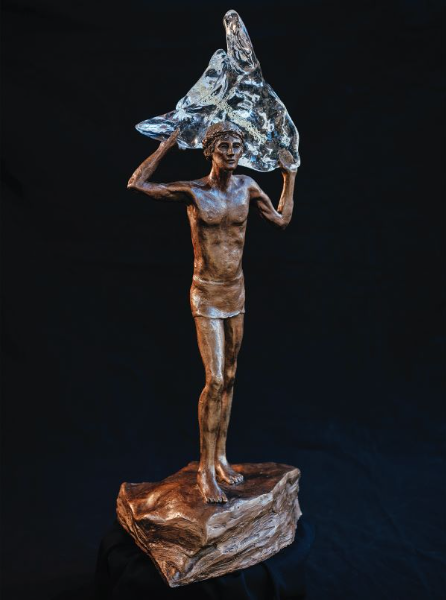Crossings Toronto - VM - John Franklin
Patricia June Vickers: Betrayal

Sorrow and Hope
by John Franklin
There is no pre-crucifixion Christianity. At the heart of the Christian faith is an ignominious execution. This idea brought scorn upon the early church. The Apostle Paul notes the “scandal” of the cross that is for some a stumbling block and for others simply foolishness. (I Cor. 1:18-25) And yet the narrative has survived. One could say it has been a shaping narrative for Western culture. A brief look at the history of visual art and music makes clear that the Passion stories of the Gospels have drawn the attention of artists for centuries. Crossings Toronto, an all outdoor exhibition on the Scriptural Stations of the Cross, follows that tradition.
This reflection offers brief comments on three of the artworks in the Crossings exhibition on in Toronto March 2 – April 14, 2022.
We rightly think of the Passion narrative as a deeply religious story and so it is. It’s a story of a path taken for the purpose of redemption, of making the crooked straight and the rough places plain. It is also a deeply human story as it speaks to the darkness of our human practices and calls us to address that darkness. Betrayal, misuse of power, injustice, dishonesty and deception, failure or refusal to understand, violence and suffering are all found in this narrative. But there is more. There is forgiveness, vulnerability for the sake of the other, compassion and hope all bound together by love.
Aboriginal artist Patricia June Vickers has done a simple and eloquent work on the theme of betrayal. (Station 2 Judas’ Betrayal) This painting (above) expresses well the sense of isolation that comes when one is betrayed. The stark red figure wounded by broken trust and enveloped in darkness provides a glimpse into the experience of betrayal, a harsh and difficult reality.
It's an experience known all too well in the Aboriginal communities of Canada. The pain that comes with betrayal wounds the spirit and is in some ways more acute that the pain of physical suffering. Yet even betrayal is not beyond the possibility of healing and redemption.

Jesus was crucified between two criminals, thieves, guilty of what at the time was a capital offence. One speaks in dismissive, deriding self -interested tones. “Are you the Messiah? Save yourself and us.” The second had a different spirit and was able to discern more clearly than many who is was next to him. He uttered what is essentially a prayer, “Jesus remember me when you come into your kingdom.”
Komi Olaf has captured this moment in his painting, a work ladened with emotion. It’s a moment of loss and lament, of sadness and fear all well expressed in the faces of the figures. The artist has brought the story into the present in two ways. One is the scene of modern Jerusalem in the distance and the other is his deeply personal engagement through figures from his own cultural background. The repentant thief – the one on the left with bowed head – has a humility of spirit, well aware of his own offences and his need for forgiveness. This is a disposition all too rare in current society where the shrill voice of entitlement seems to dominate.

Jesus takes up the cross, a sculpture by Colleen McLaughlin Barlow, takes the viewer on an unexpected journey. There is no brutalized and broken body, no wooden beams draped on a bent figure. Instead there is a strong and confident figure serene and resolute, intent on an obedient walking of the path before him. And held up above his shoulders a crystal clear form of the human sacrum, a bone structure found in all human bodies at the back of the pelvis and containing within it the shape of a cross. The symbolism here is that Christ takes his journey to death bearing the weight of all human sinfulness. The quiet beauty of the face is a reminder that the one who died on our behalf did so with full awareness of what the path before him would entail and yet did not flinch from becoming a willing sacrifice for the sake of the world.
These and the other works in the Crossings exhibition in Toronto call us to fresh engagement with the profound and ancient story of the Passion of Christ.
*******
Patricia June Vickers: Betrayal, 2021, acrylic on canvas, 24” x 18”.
Komi Olaf: The Good Thief, 2021, oil on canvas, 3” x 5”.
Colleen McLaughlin Barlow: Jesus Takes Up the Cross, 2021, bronze and acrylic, 32” h.
Patricia June Vickers is a Haida Gwaii First Nations artist from British Columbia, Canada.
Komi Olaf is a Nigerian Canadian resident in Toronto, Canada.
Colleen McLaughlin Barlow is a Canadian artist, now resident in Cambridge UK,
John Franklin is Executive Director of IMAGO and Curator of Crossings Toronto, Canada.
Crossings: Until 14 April, various locations in Toronto: Crossings, a Journey to Easter Arts Exhibition. Crossings is part of a series of exhibitions that have taken place in London England, Washington DC, New York City and Amsterdam. The Toronto exhibition is scheduled during the time in the church calendar known as Lent. This project has been initiated by IMAGO, now in its 49th year serving church and culture at the interface of faith and art. Crossings will be free for the public to visit. The artworks are being done by sixteen Canadian artists in response to the Scriptural Stations of the Cross and will be uniquely relevant expressions capturing both the Passion narrative and its implications for our world. The title Crossings aligns with “Toronto” – Huron for “meeting place”, and fits with our city’s identity as an intersection of ethnicities, cultures, races, religions and ideas. It also alludes to the possibility for spiritual encounter through engagement with the Passion story. The locations selected for the art will allow the public to make a “pilgrimage” to the Stations. There will be eleven located on or near the University of Toronto campus and five at churches in the Yonge and St. Clair area of the city. https://www.crossingstoronto.com
ArtWay Visual Meditation March 13, 2022


